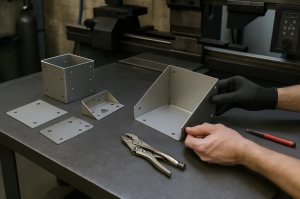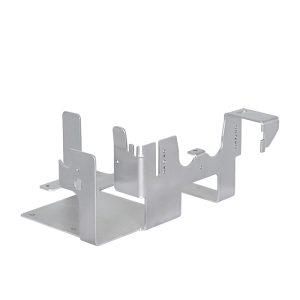
How Does Prototyping Work in Sheet Metal Fabrication?
Release time:2025-06-26 Click:153Sheet metal fabrication is a cornerstone of modern manufacturing, enabling the creation of precise, durable, and versatile components used across industries like automotive, aerospace, electronics, and construction. At the heart of this process lies prototyping, a critical step that bridges the gap between conceptual design and full-scale production. Prototyping in sheet metal fabrication allows manufacturers to test designs, validate functionality, and refine components before committing to costly production runs. This article explores the intricacies of sheet metal prototyping, addressing key questions to help potential customers understand its importance, processes, benefits, and applications. By delving into each aspect, we aim to provide a comprehensive guide optimized for search engines and valuable for those seeking professional sheet metal services in Mexico.
Sheet metal prototyping is the process of creating a preliminary version of a metal component to evaluate its design, functionality, and manufacturability. Unlike final production parts, prototypes are typically produced in small quantities, allowing engineers and designers to test concepts without the expense of mass production. Prototypes can range from simple flat patterns to complex assemblies, depending on the project’s requirements.
The primary goal of prototyping is to identify and address potential issues early in the design phase. This might include testing the fit of a component within an assembly, verifying material strength, or ensuring the part meets aesthetic and functional specifications. By creating prototypes, manufacturers can refine designs, reduce risks, and ensure the final product aligns with customer expectations.
Prototyping is especially crucial in sheet metal fabrication due to the unique properties of metal, such as its strength, weight, and response to forming processes. Whether it’s a custom bracket for an automotive application or a precision enclosure for electronics, prototyping ensures that the final product is both functional and cost-effective.

Prototyping plays a pivotal role in sheet metal fabrication for several reasons. First, it allows manufacturers to validate designs before committing to expensive tooling or large-scale production. Errors in design, such as incorrect dimensions or incompatible materials, can be costly to fix once production begins. Prototyping mitigates these risks by catching issues early.
Second, prototyping facilitates collaboration between designers, engineers, and clients. By creating a tangible model, stakeholders can provide feedback, suggest improvements, and ensure the design meets their needs. This iterative process reduces misunderstandings and aligns expectations.
Third, prototyping helps optimize manufacturing processes. Sheet metal fabrication involves techniques like cutting, bending, and welding, each of which can introduce variables that affect the final product. Prototyping allows manufacturers to test these processes, ensuring they are efficient and produce consistent results.
Finally, prototyping supports innovation. By experimenting with new designs, materials, or fabrication techniques, manufacturers can push the boundaries of what’s possible, creating components that are lighter, stronger, or more cost-effective.
The sheet metal prototyping process typically follows a structured workflow, ensuring that each prototype is created efficiently and meets design requirements. Below are the key steps involved:
The process begins with a detailed design, often created using computer-aided design (CAD) software. Designers work closely with clients to understand the component’s purpose, specifications, and constraints. The CAD model includes precise measurements, material specifications, and tolerances, serving as the blueprint for the prototype.
Choosing the right material is critical in sheet metal prototyping. Common materials include steel, aluminum, stainless steel, and copper, each with unique properties like strength, corrosion resistance, and weight. The choice depends on the part’s intended use, environmental conditions, and budget. Prototyping allows manufacturers to test different materials to find the optimal balance of performance and cost.
Once the design and materials are finalized, the prototype is fabricated using techniques such as laser cutting, CNC punching, bending, or welding. Advanced technologies like CNC machining and 3D printing may also be used for complex or low-volume prototypes. The goal is to create a functional model that closely resembles the final product.
The prototype is subjected to rigorous testing to assess its performance. This may include stress testing, dimensional verification, or fit testing within an assembly. Feedback from these tests helps identify design flaws, material issues, or manufacturing challenges.
Based on testing results, the design may be refined to address any issues. This iterative process may involve multiple prototype versions, each improving on the previous one. CAD software allows for quick adjustments, ensuring the design evolves efficiently.
Once the prototype meets all requirements, it is validated for production. This may involve creating a small batch of prototypes for further testing or client approval before moving to full-scale manufacturing.

Sheet metal prototyping relies on a range of advanced technologies to achieve precision and efficiency. Below are some of the most common tools and methods used:
Computer-aided design (CAD) and computer-aided manufacturing (CAM) software are essential for creating and producing prototypes. CAD allows designers to create detailed 3D models, while CAM translates these designs into instructions for manufacturing equipment. These tools ensure accuracy and streamline the prototyping process.
Laser cutting uses a high-powered laser to cut precise shapes from sheet metal. This technology is ideal for prototyping because it offers high accuracy, minimal material waste, and the ability to handle complex geometries.
Computer numerical control (CNC) machining involves automated tools that cut, bend, or punch sheet metal based on programmed instructions. CNC machines are highly versatile, making them suitable for both simple and intricate prototypes.
While not a traditional sheet metal process, 3D printing is increasingly used for rapid prototyping, especially for complex components or molds. It allows manufacturers to create test parts quickly before committing to metal fabrication.
Waterjet cutting uses a high-pressure stream of water mixed with abrasive materials to cut sheet metal. This method is ideal for materials sensitive to heat, as it produces no thermal distortion.
For prototypes requiring formed parts, rapid tooling creates temporary or low-cost molds and dies. This allows manufacturers to test forming processes without investing in expensive production tooling.
These technologies enable manufacturers to produce high-quality prototypes quickly, reducing lead times and costs for clients.
Prototyping is often seen as an additional step in the manufacturing process, but it can significantly reduce costs and timelines in the long run. Here’s how:
By identifying design flaws or manufacturing issues during prototyping, manufacturers can avoid costly rework during production. Fixing a design error in the prototype stage is far less expensive than modifying tooling or scrapping defective parts later.
Prototyping allows manufacturers to test different materials and thicknesses, ensuring the final product uses the most cost-effective options without compromising quality.
A thoroughly tested prototype ensures that production runs smoothly, minimizing delays caused by unexpected issues. This is especially important for industries with tight schedules, such as automotive or aerospace.
Prototyping ensures that the final product meets client expectations, reducing the risk of returns or revisions. This builds trust and fosters long-term relationships with customers.
By refining processes during prototyping, manufacturers can optimize production techniques, reducing waste and improving efficiency. This leads to faster turnaround times and lower costs.
While prototyping offers numerous benefits, it also comes with challenges that manufacturers must address:
Creating prototypes requires time, materials, and skilled labor, which can be costly, especially for complex designs. However, these costs are often offset by the savings achieved through error prevention.
Prototyping can extend the overall project timeline, particularly if multiple iterations are needed. Manufacturers must balance the need for thorough testing with the client’s schedule.
Some materials may behave differently during prototyping than in production due to variations in batch sizes or equipment. Manufacturers must account for these differences to ensure consistency.
Complex designs with tight tolerances or intricate geometries can be challenging to prototype accurately. Advanced technologies like CNC machining or laser cutting help mitigate this issue.
Miscommunication between clients and manufacturers can lead to prototypes that don’t meet expectations. Clear documentation and regular feedback loops are essential to avoid this.
By addressing these challenges proactively, manufacturers can ensure a smooth prototyping process that delivers high-quality results.
Sheet metal prototyping serves a wide range of industries, each with unique requirements. Below are some examples:
Prototyping is used to create components like brackets, chassis parts, and exhaust systems. These prototypes are tested for fit, durability, and performance under real-world conditions.
In aerospace, precision is paramount. Prototypes for parts like airframe components or engine mounts are rigorously tested to meet strict safety and regulatory standards.
Sheet metal prototypes for enclosures, racks, and heat sinks are tested for thermal performance, electromagnetic shielding, and compatibility with electronic components.
Prototyping is used to create structural components like beams, supports, or cladding panels. These prototypes ensure compatibility with architectural designs and building codes.
Medical devices often require custom sheet metal components, such as instrument trays or equipment housings. Prototyping ensures these parts meet hygiene and functionality standards.
By tailoring prototyping processes to industry-specific needs, manufacturers can deliver components that meet stringent requirements while maintaining efficiency.
To maximize the benefits of prototyping, manufacturers should follow these best practices:
Engage clients from the design phase to ensure prototypes align with their goals. Regular communication helps avoid costly revisions.
Leverage tools like CAD, CNC machining, and laser cutting to produce accurate prototypes quickly. These technologies reduce lead times and improve quality.
Conduct comprehensive testing to evaluate all aspects of the prototype, including fit, function, and durability. Use real-world conditions whenever possible.
Maintain detailed records of design iterations, testing results, and client feedback. This documentation streamlines future iterations and production.
Design prototypes with production in mind, ensuring that manufacturing processes can be scaled up efficiently without compromising quality.
By adhering to these practices, manufacturers can create prototypes that pave the way for successful production runs.
For businesses seeking reliable sheet metal prototyping services in Mexico, Mexmach offers professional metal machining and fabrication solutions tailored to your needs. With state-of-the-art equipment, experienced engineers, and a commitment to quality, Mexmach delivers high-precision prototypes that meet industry standards. Whether you’re in automotive, aerospace, electronics, or another sector, Mexmach’s expertise ensures your designs are validated efficiently and cost-effectively, setting the stage for seamless production. Contact Mexmach today to learn how we can support your next project with our professional metal machining services.